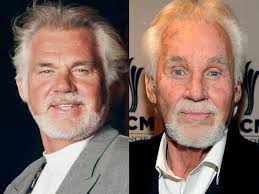Natural eyelids: “Don’t make me look like Kenny”
(Part 2 of a series on eyelid surgery problems and how to deal with them)
Each day in my office, meeting with different patients who would like eyelid plastic surgery or upper facial surgery, the most common comment I get is “I just don’t want to look like Kenny Rogers.” I feel really bad about this, because I grew up listening to Kenny Rogers and watching the Gambler. I think Kenny Rogers has a lot of talent and it’s a shame he is constantly maligned. I started looking into what it is about his appearance that is so troubling to so many people. Kenny himself talked about his plastic surgery and how he feels it did not come out the way he wanted. This got me thinking about the conversation that patients need to have with their doctors before eyelid plastic surgery to ensure they’ll have natural eyelids when all is said and done.

Kenny Rogers: Before and after eyelid and brow lift
As I looked at Kenny Rogers’ before and after photos I noticed a couple of things. First of all, it appears that he has had a fairly aggressive brow lift and removal of fat. When you see his pictures from the mid 80’s, he has quite heavy brows and upper eyelids which gave him a distinctive look (i.e. natural eyelids). He was also a bit overweight, which filled in a lot of facial wrinkles. He was out of the limelight during his weight loss and surgery, so no one observed what was likely a gradual change. After surgery, he had a great reduction in the fat beneath his brows and a big change in the position of his eyebrows. His eyebrows are pulled much too high for what one would expect to see in a male brow (most male brows are flat and rest about at the edge of the upper eye socket). His new look gave him a startled look to the eyes. There was also a significant amount of upper eyelid fat that was removed during his eyelid plastic surgery, giving the eyelids a sunken in appearance. They almost appear to be stuck to his eyeballs. I’m sure that in his preoperative counseling with his doctor, this wasn’t perfectly communicated to him.
Strive for natural in eyelid plastic surgery
In my eyelid plastic surgery preoperative counseling, I try to discuss with my patients how to achieve a natural appearance. By deconstructing normal facial proportions, one can decide the ultimate look they are trying to achieve. For example, when looking at a teenage girl, in most cases the eyebrows will be high and arching. Over time, and with age, the eyebrows will become slightly more flat and will descend. If a woman in her 50’s or 60’s or older desires a brow lift, I would counsel her that the eyebrows should not be excessively high. This can result in a surprised look. The patient will look surprised for two reasons. One, the eyelids are so far open that they look startled. The second, one portion of the face looks overly rejuvenated while the rest of the face still maintains an aged appearance. Making more subtle changes, something some surgeons don’t seem able to do in many cases, will grant you much more metered and natural results.
Just the right amount of eyelid plastic surgery
Asking your surgeon to “do as much as they can” or “take out as much fat as possible” is a bad idea. The question you should be asking is that they take out just the right amount. This right amount should be discussed with your surgeon prior to eyelid plastic surgery and you should both be comfortable with it. It may even be preferable to do the surgery in two stages: starting out conservatively, with a second procedure only if necessary. I always tell patients that it is a lot easier to take more later than to put back what was already taken. Bottom line, it is important to have an honest discussion with your surgeon about realistic expectations and how your appearance will change. It’s my experience that most people don’t have a clear vision in their mind about how their appearance will change, and this is the most common reason why they are disappointed after surgery.
